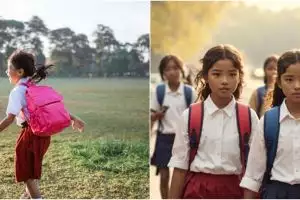Brilio.net - Education for children is an important thing that must be considered. The reason is, education can influence a child's growth and development. Where growth is in harmony with brain development so that there is no delay in the learning process. One way you can prepare education for your child is by providing a place or forum such as a school.
Apart from basic education provided at home, school can also shape a child's growth and development. One method for developing children's growth and development is numeracy literacy - an individual's ability to understand, use and interpret numerical information in various contexts.
This method includes understanding mathematical concepts, applying mathematical skills in everyday life, and the ability to make decisions based on numerical information.
Numeracy literacy in schools is an important skill for students to understand, use and think critically about numbers, data and mathematical concepts in various contexts.
Some examples of numeracy literacy in schools involve skills such as mathematical problem solving, use of data and statistics, and the ability to think critically about information involving numbers.
The goal of numeracy literacy aims to provide individuals with the ability to function effectively in a modern society that is increasingly dependent on numerical information and concepts.
Numeracy literacy is a learning approach that can be applied directly to students' lives at school and outside the school environment. Examples of numeracy literacy in schools usually include contextual mathematics learning, where each student not only understands mathematical concepts, but is also able to relate them to real world situations.
Apart from that, you can also use technology application tools, such as mathematics software and calculators. This method can also be part of numeracy literacy to prepare students to face the demands of the modern world which is increasingly related to technology.
The following is an example of numeracy literacy in school that you can understand and learn, as reported by brilio.net from various sources, Friday (1/3).
Examples of numeracy literacy in schools

example of numeracy literacy
freepik.com
1. Buy food in the canteen

example of numeracy literacy
freepik.com
The canteen is part of the school environment. Therefore, the canteen can be a means for learning numerical literacy, such as buying food in the canteen and doing calculations to find out the amount that must be paid, giving money and calculating the money returned.
2. Time management

example of numeracy literacy
freepik.com
In school education, time is an important thing to apply. So in time management, students can use numeracy literacy as a tool to plan activities such as making study schedules, setting time limits for assignments, and calculating the duration of time required for certain activities.
3. Applied mathematics project
example of numeracy literacy
freepik.com
In school education, mathematics is one of the subjects that can be used as a direct example of numeracy literacy education. one example is by getting involved in a math project that uses measuring and calculating tools.
Measurements and calculations around the school can be related to measuring the size of a classroom, counting the number of books in the library, or evaluating the amount of materials for an art project.
4. Math puzzle
Playing math puzzles can be an option to apply numeracy literacy such as using problem solving in mathematics.
However, mathematics is a subject that students are quite afraid of. Therefore, teaching them certain tricks will make it easier for children to recognize and like numbers and counting.
Ways you can teach students can be using games, real use, drawing graphs and so on. Reporting from brilio.net, compiled from various sources, here are how to teach students to understand numeracy literacy in a more creative way:
- Introduction to numbers and calculations
You can use tools around you such as cardboard numbers, building blocks, or cartoon pictures to teach students about numbers and how to count.
- Math game
You can use various games to teach numeracy literacy such as mathematical bingo, games with numbers, and you can also use cards that involve counting and basic mathematical operations.
- Simple math problem solving
You can also give examples of simple math problems that they have to solve such as "if there are 3 sapodillas and you eat 1, how many are left?"
5. Use of Real Objects
example of numeracy literacy
freepik.com/freepik.com
Real objects can be materials for teaching numeracy literacy and you can also apply them to teach students at school. such as pieces of fruit, coins, or measuring tools to measure and teach the concepts of measurement and comparison.
6. Counting Money
example of numeracy literacy
freepik.com/freepik.com
Counting money can be quite effective learning when taught to students at school. Coins and banknotes can be used to stimulate real events such as playing shopping.
7. Drawing Graphics
Next, you can teach how to draw graphs and collect simple data such as bar or circle graphs based on that data.
8. Comparison activities
Comparisons can be used for various numeracy literacy learning objects, such as finding out which objects are bigger or which objects are smaller.
9. Play with the clock
The clock can be a teaching object for students who have difficulty understanding mathematics. Clocks can be a good approach to teaching numeracy literacy such as reading and managing watches or wall clocks.
10. Mathematics activities in the open air
Next, you can use learning methods in nature. This activity can make learning about mathematics more fun, such as counting leaves, flowers or animals in their environment.
11. Mathematics competition
example of numeracy literacy
freepik.com/freepik.com
Mathematics competitions can be used as a tool to introduce numeracy literacy because they encourage students' interest in mathematics and test their skills.
